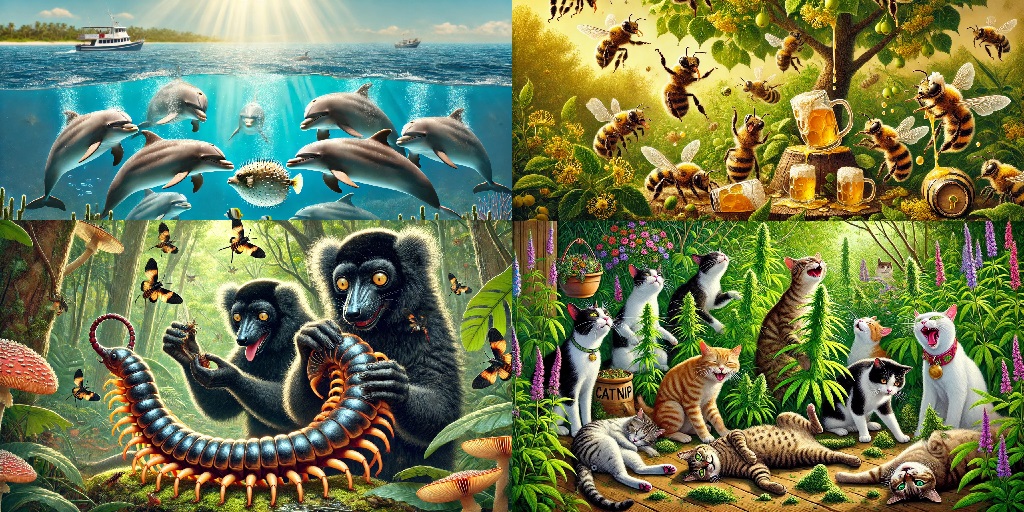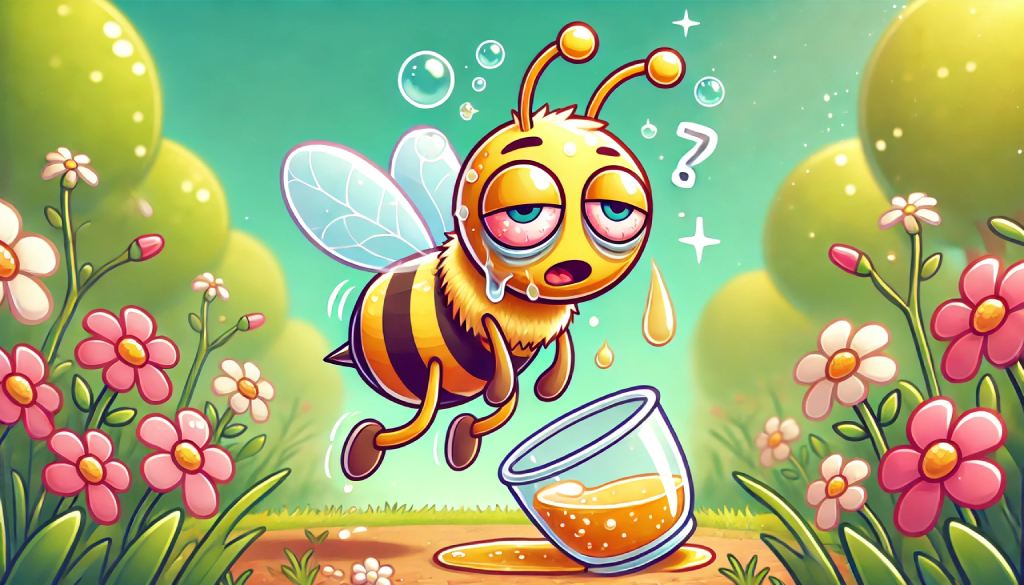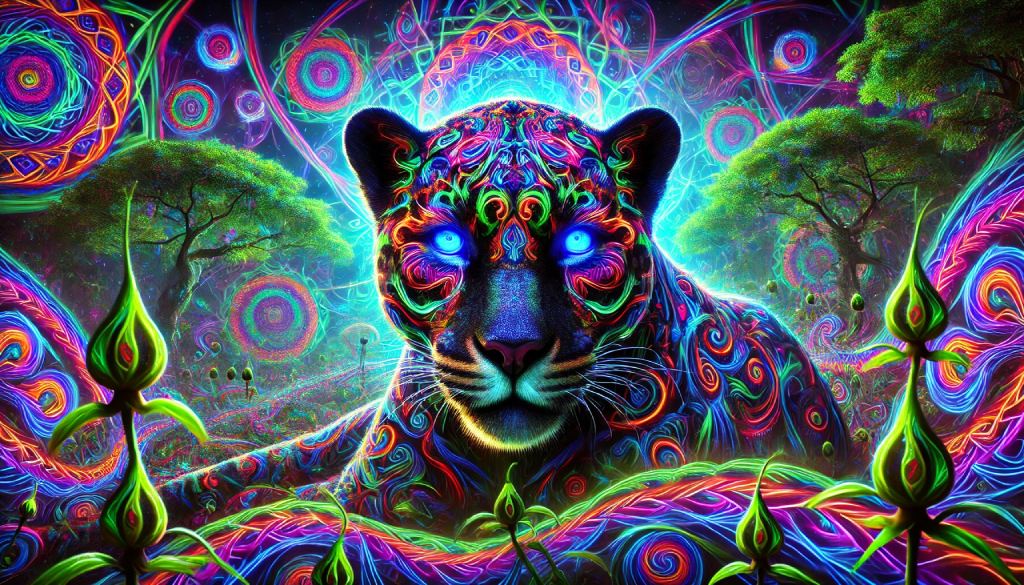
We humans are not the only inhabitants of our planet who occasionally like to get high! Other animals also seem to be quite good at it. Of course, we can never know exactly what thoughts play in the minds of animals. However, several examples of recreational drug use by animals in nature have been observed. In this blog, we give 10 examples of animals that occasionally like to expand their consciousness.
Dolphins play with pufferfish
Let’s start with the smartest animals of the underwater world, the dolphin. They have a very peculiar ritual. A group of dolphins goes in search of a mildly toxic pufferfish. Once they find one, they take the fish in their mouths and pass it around like a joint. And they find it dol-fine! They get high from the toxin that the pufferfish secretes when it’s scared. Although the toxin is deadly in large quantities, in small amounts it only causes a light narcotic effect. Their eyes shrink, and they swim on their backs to the surface of the water while the poor pufferfish escapes, defeated.
Cats munch on catnip
Our beloved pets are actually hardcore junkies when it comes to catnip. Well, most cats anyway. About two-thirds of all cats are genetically inclined to trip on catnip (also known as catmint). The plant Nepeta cataria contains various essential oils, including nepetalactone. They absolutely love this stuff: after licking, smelling, eating, or rubbing against it, they start hallucinating. They become mega happy or excited and may start drooling, rolling around, and purring. A catnip trip lasts about 10-15 minutes and is neither harmful nor addictive. If your cat has been really good and deserves a proper reward, this is the way to go!
Bees love a drink
Bees are naturally fond of sweet things. All summer long, they search for pollen and nectar from various plants, such as the sap of the linden tree. In a particularly warm summer, the sap may start to ferment. When bees drink this sap, they quickly become quite drunk. Like humans, their motor skills rapidly decline under the influence. They fly into things, forget where they were going, or simply lie on their backs and refuse to fly further.

Drunken bees get the death penalty
This is where the story becomes a bit less cheerful. A drunken bee that returns to its hive does not do so without consequences. When bees ‘come home’, they perform a kind of waggle dance. In specific patterns, they walk back and forth, shaking their abdomens and wings. This is how they communicate, among other things, how far and in which direction food can be found. If a bee is drunk, it’s immediately noticeable, and the guard bees approach the drunken bee and bite off its legs. They do this to warn the rest of the hive that sloppy behavior is absolutely not tolerated in the busy bee life.
Monkeys hallucinate on millipede sap
On the beautiful island of Madagascar, the black lemurs know how to party. These clever mammals have discovered a handy lifehack. They grab a millipede and gently bite into it until it releases its defensive chemicals. One of the substances that is released is cyanide. They rub this stuff into their fur, which keeps all insects at bay. However, during this process, they also get Apestoned. In small amounts, cyanide is not lethal, but it does cause hallucinations and a euphoric state.
Wallabies hop on opium
In Tasmania, an island belonging to Australia, there are many vast poppy fields. The opium derived from poppies is highly lucrative. It is used to produce painkillers such as morphine and codeine. The notorious drug heroin is also made from the same plant. However, this only works if the wallabies don’t interfere. These little cousins of kangaroos invade the poppy fields and start chewing on the poppy heads until they are under the influence. They have previously made the news as an alternative explanation for crop circles, which were believed to have been left by aliens. Whether that’s true or not, it’s certain that wallabies hop around completely high until they collapse and fall asleep.
Reindeer trip on fly agaric
Voluntarily eating psychedelic mushrooms? We are definitely not the only ones. In Eastern Europe, reindeer actively search for the fly agaric (Amanita muscaria), the iconic red mushroom with white spots. Long ago, herders discovered that the urine of a reindeer that had eaten this mushroom was 'safe' to drink and caused hallucinations. It is said that these trips often involve flying, and there are theories that suggest this is where the story of Rudolph and the flying Santa originated. Ho ho holy shit…
Birds bathe in formic acid
There are many different ways to get stoned or trip. You can make tea from weed, bake a delicious space cake or smoke it in a bong. A less pleasant method is to find an ant nest and rub the entire colony over your body as if it were sunscreen. However, this is exactly what birds like starlings, jays, ravens, and crows do to get out of their minds. These birds use ants in two ways: they either grab the ants and rub them into their feathers, or they find a nest and sit on it until they are covered in ants. This ant scrub is actually intended to deter other insects and parasites, as the ants secrete a type of methanoic acid (also known as formic acid).
Jaguars gnaw on caapi bark
In the Amazon rainforest, jaguars occasionally take a break from their hectic hunting lifestyle to gnaw on the bark of the Yage vine (Banisteriopsis caapi). This does not happen without consequences. Similar to the (house)cats on this list, it leads to strange behavior. The Yage vine, better known to us in Europe as the ayahuasca vine, contains several powerful MAO inhibitors. This stimulates the senses of the jaguars and causes them to trip. Some theories suggest that the Tucano Indians discovered ayahuasca by observing the hallucinating jaguars.
Horses love locoweed
In America, horses go crazy for the plant locoweed (Oxytropis lambertii). Not to be confused with weed, as they have nothing in common. When horses eat this plant, they start jumping, galloping, and neighing until they can no longer stand. The horses love locoweed. Unfortunately, the plant contains the highly addictive swainsonine, a powerful alkaloid. The horses quickly become addicted to the toxic plant, which can have deadly consequences for them. Say no to locoweed, horsies!
Bighorn sheep and psychoactive lichen
In the Canadian Rockies, there is a unique neon yellow-green species of lichen that will give you the trip of a lifetime. This species of lichen is extremely rare and takes decades to grow on a single rock. It often grows in very hard-to-reach places such as narrow ledges and jagged rock edges. Nevertheless, bighorn sheep risk their lives to find this psychedelic lichen. Very remarkable, according to experts, since these sheep are normally social animals that do not often stray from their herd. When the bighorn sheep finally find a portion of lichen, they scrape the rocks clean with their teeth until they have eaten it all. Some rare lichens can contain cocktails of 5-MeO-DMT and psilocybin, and they have been found in Iceland and Ecuador. Perhaps this is one such lichen!
Honorable Mention: Bats fly drunk
Finally, an honorable mention for the bats in Central and South America. They regularly eat fermented fruit containing up to 4.5% alcohol, but unlike the bees on this list, they are lucky enough to resist the effects. A 2009 study showed that even bats that were completely drunk effortlessly avoided obstacles while flying [1]. Never fly drunk, unless your sonar is well developed!
Sources
- [1]https://journals.plos.org/plosone/article?id=10.1371/journal.pone.0008993
- https://savannahbee.com/blogs/the-latest-buzz/yes-bees-can-get-drunk
- https://www.csiro.au/en/news/All/Articles/2017/June/party-animals-wildlife-that-get-drunk-or-high
- https://www.australiangeographic.com.au/topics/wildlife/2011/10/animals-getting-high-10-common-drunks/